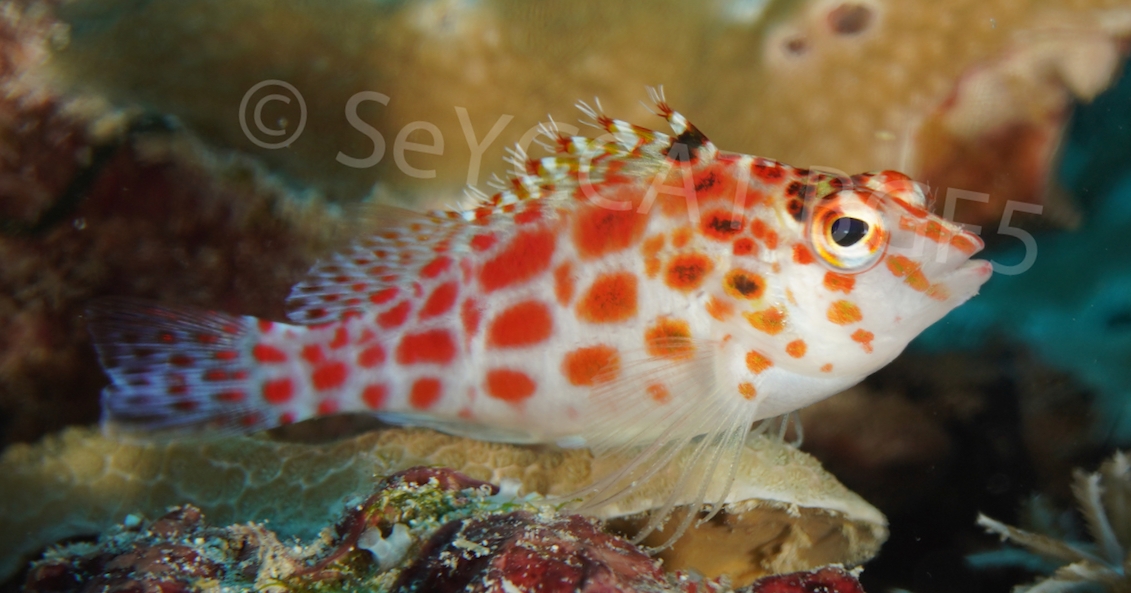Description:
Dorsal spines: 10; Dorsal rays: 12-13; Anal spines: 3; Anal rays: 6.
Small, moderately full-bodied hawkfish. Maxilla reaching or extending past vertical at front edge of eye. 4 rows of scales on cheek. Interorbital space not scaled. Preopercle
coarsely serrate. 3 scale rows above lateral line. 5th dorsal spine longest. A tuft of cirri near tip of each dorsal spine. Membranes of spinous dorsal fin moderately incised.
Colour. Highly variable in colour. Base colour is light white to pink. Colour of spots varies from grey to black or orangish to red. Horizontal rows of oblong to
subquadrate spots on body. A row of smaller spots on the lateral line between the larger spots. Small dark spots on head and nape. 2 bands of spots radiate ventrally from eye.
Spots on the spinous dorsal fin including blotches along the fin base, and spotted soft dorsal and caudal fins. Pectoral fins transparent.
Size:
Maturity: Unknown. Max length : 10.0 cm TL.
Habitat and Ecology:
Inhabits areas of rich coral growth and clear water of lagoon, channel, or seaward reefs (depth 1-40 m, usually 10-25 m). Benthic. Rest on, in or beneath corals. Feed on
crustaceans and small fishes. Males are territorial and haremic. Spawning occurs in the water column.
Fishery Status:
This species is not protected or subject to fishery regulations. It is not subject to the artisanal fishery.
Notes:
Photo courtesy Eleanor Brighton and Chris Mason-Parker (c) 2022 Blue Safari Seychelles/Marine Conservation Society, Seychelles. Photograph taken at Alphonse group 2022.
References:
Bray, D.J. Cirrhitichthys oxycephalus in Fishes of Australia, https://fishesofaustralia.net.au/home/species/437 (23/07/22).
Froese, R. & D. Pauly. (Eds.) (2022). FishBase. https://www.fishbase.se/summary/Cirrhitichthys-oxycephalus.html (22/07/22).
Greenfield, D. & Williams, I. (2016). Cirrhitichthys oxycephalus (errata version 2017). The IUCN Red List 2016: https://dx.doi.org/10.2305/IUCN.UK.2016-1.RLTS.T67997668A68001661.en. (22/07/22).
Smith, M. & Heemstra, P. (Eds.) (1999). Smiths’ Sea Fishes Edition 6. Springer-Verlag Berlin Heidelberg 10.1007/978-3-642-82858-4
Citation:
Nevill, J.E.G., Brighton, E. & Mason-Parker, C. (2022). Cirrhitichthys oxycephalus, Coral hawkfish. Seychelles Seatizens. www.seatizens.sc. https://seatizens.sc/species/cirrhitichthys-oxycephalus-bleeker-1855/


pin up azerbaycan: pin up onlayn kazino – pin up giris
buying prescription drugs in mexico: mexican northern doctors – medication from mexico pharmacy
http://northern-doctors.org/# medicine in mexico pharmacies
п»їbest mexican online pharmacies: mexican border pharmacies shipping to usa – buying prescription drugs in mexico online
mexico pharmacies prescription drugs mexican pharmacy northern doctors reputable mexican pharmacies online
http://northern-doctors.org/# mexico pharmacies prescription drugs
purple pharmacy mexico price list mexican northern doctors mexico pharmacies prescription drugs
http://northern-doctors.org/# mexico drug stores pharmacies
mexico drug stores pharmacies Mexico pharmacy that ship to usa medication from mexico pharmacy
mexican border pharmacies shipping to usa: mexican pharmacy – buying prescription drugs in mexico
п»їbest mexican online pharmacies: mexican rx online – mexico drug stores pharmacies
https://northern-doctors.org/# best online pharmacies in mexico
mexican mail order pharmacies: mexican drugstore online – mexico drug stores pharmacies
mexico drug stores pharmacies: mexican pharmacy online – reputable mexican pharmacies online
https://northern-doctors.org/# pharmacies in mexico that ship to usa
mexico pharmacy: northern doctors pharmacy – buying from online mexican pharmacy
buying prescription drugs in mexico: Mexico pharmacy that ship to usa – purple pharmacy mexico price list
mexican rx online mexican pharmacy reputable mexican pharmacies online
https://northern-doctors.org/# mexican mail order pharmacies
mexican rx online: mexican mail order pharmacies – mexico pharmacies prescription drugs
reputable mexican pharmacies online: mexican drugstore online – mexican rx online
http://northern-doctors.org/# mexican drugstore online
mexico pharmacy: mexican northern doctors – mexican border pharmacies shipping to usa
mexican border pharmacies shipping to usa: northern doctors pharmacy – mexican rx online
mexican mail order pharmacies: mexican pharmacy online – п»їbest mexican online pharmacies
https://northern-doctors.org/# mexican mail order pharmacies
mexican drugstore online: northern doctors – mexican rx online
buying prescription drugs in mexico: mexican northern doctors – pharmacies in mexico that ship to usa
http://northern-doctors.org/# mexican pharmacy
medication from mexico pharmacy mexican pharmacy online purple pharmacy mexico price list
mexican online pharmacies prescription drugs: mexican northern doctors – mexico pharmacy
п»їbest mexican online pharmacies: northern doctors – buying from online mexican pharmacy
purple pharmacy mexico price list: mexican pharmacy – mexican drugstore online
https://northern-doctors.org/# mexican pharmacy
buying from online mexican pharmacy: mexico pharmacy – mexican drugstore online
reputable mexican pharmacies online northern doctors mexico pharmacies prescription drugs
mexican mail order pharmacies: Mexico pharmacy that ship to usa – mexican rx online
https://northern-doctors.org/# mexico drug stores pharmacies
mexican online pharmacies prescription drugs: mexican pharmacy northern doctors – mexico pharmacy
mexican rx online: northern doctors pharmacy – pharmacies in mexico that ship to usa
mexican pharmaceuticals online: mexican pharmacy – mexico pharmacies prescription drugs
best online pharmacies in mexico: northern doctors – pharmacies in mexico that ship to usa
http://northern-doctors.org/# medicine in mexico pharmacies
mexico pharmacies prescription drugs mexican northern doctors mexico drug stores pharmacies
mexican border pharmacies shipping to usa: mexican pharmacy online – mexican border pharmacies shipping to usa
mexican rx online: pharmacies in mexico that ship to usa – buying prescription drugs in mexico online
https://northern-doctors.org/# mexican online pharmacies prescription drugs
mexican rx online: mexican pharmacy northern doctors – mexican rx online
https://northern-doctors.org/# buying from online mexican pharmacy
mexican online pharmacies prescription drugs: mexican pharmacy – mexican pharmaceuticals online
https://northern-doctors.org/# medicine in mexico pharmacies
mexican pharmacy: mexican pharmacy northern doctors – mexican rx online
buying from online mexican pharmacy: mexican pharmacy online – mexican rx online
Great mix of humor and insight! For additional info, click here: READ MORE. Any thoughts?
mexican mail order pharmacies: mexican pharmacy – mexican drugstore online
http://northern-doctors.org/# pharmacies in mexico that ship to usa
buying from online mexican pharmacy: northern doctors pharmacy – mexico drug stores pharmacies
buying prescription drugs in mexico online mexican pharmacy online purple pharmacy mexico price list
https://northern-doctors.org/# pharmacies in mexico that ship to usa
medicine in mexico pharmacies: Mexico pharmacy that ship to usa – п»їbest mexican online pharmacies
https://northern-doctors.org/# mexican border pharmacies shipping to usa
pharmacies in mexico that ship to usa: mexican drugstore online – mexican pharmaceuticals online
https://northern-doctors.org/# best online pharmacies in mexico
mexico pharmacies prescription drugs Mexico pharmacy that ship to usa buying from online mexican pharmacy
mexico drug stores pharmacies: Mexico pharmacy that ship to usa – pharmacies in mexico that ship to usa
https://northern-doctors.org/# medicine in mexico pharmacies
http://northern-doctors.org/# mexican border pharmacies shipping to usa
mexican rx online: mexican pharmacy – best online pharmacies in mexico
mexican drugstore online cmqpharma.com pharmacies in mexico that ship to usa
http://cmqpharma.com/# buying from online mexican pharmacy
mexican pharmacy
buying from online mexican pharmacy: mexico pharmacy – purple pharmacy mexico price list
reputable indian online pharmacy online pharmacy india reputable indian pharmacies
indian pharmacy: reputable indian pharmacies – top 10 pharmacies in india
india pharmacy: india online pharmacy – top 10 online pharmacy in india
http://foruspharma.com/# best online pharmacies in mexico
mexican pharmacy: mexico pharmacy – medication from mexico pharmacy
buying prescription drugs in mexico п»їbest mexican online pharmacies buying from online mexican pharmacy
canada pharmacy online canadian pharmacy store canadian pharmacy 24h com
reputable indian pharmacies: top 10 online pharmacy in india – india pharmacy
http://canadapharmast.com/# canadian discount pharmacy
mexican pharmaceuticals online: mexico pharmacy – mexican mail order pharmacies
canadian pharmacy king: canadian pharmacy prices – canadian drug pharmacy
purple pharmacy mexico price list: mexico pharmacies prescription drugs – buying prescription drugs in mexico online
legit canadian pharmacy: buy drugs from canada – canadian pharmacy ltd
legit canadian pharmacy online onlinepharmaciescanada com safe online pharmacies in canada
http://indiapharmast.com/# top online pharmacy india
reputable mexican pharmacies online: reputable mexican pharmacies online – mexico pharmacy
mexican online pharmacies prescription drugs: mexico pharmacies prescription drugs – best online pharmacies in mexico
indian pharmacies safe: indian pharmacy paypal – india online pharmacy
pharmacies in mexico that ship to usa: buying from online mexican pharmacy – buying prescription drugs in mexico
best online pharmacy india: cheapest online pharmacy india – best india pharmacy
mexican mail order pharmacies mexican rx online mexico pharmacies prescription drugs
legit canadian pharmacy canadian drug stores buying drugs from canada
Online medicine order: mail order pharmacy india – cheapest online pharmacy india
http://foruspharma.com/# п»їbest mexican online pharmacies
canadian drug stores: buy drugs from canada – canadian 24 hour pharmacy
canadian pharmacy oxycodone: canadian pharmacy world – canadian pharmacy ltd
india pharmacy mail order: online shopping pharmacy india – indian pharmacies safe
http://indiapharmast.com/# online pharmacy india
india pharmacy mail order: buy medicines online in india – indian pharmacy paypal
https://ciprodelivery.pro/# purchase cipro
https://paxloviddelivery.pro/# paxlovid pharmacy
doxycycline vibramycin: doxycycline pharmacy online – doxycycline prescription coupon
https://amoxildelivery.pro/# buy amoxicillin over the counter uk
https://ciprodelivery.pro/# where can i buy cipro online
https://doxycyclinedelivery.pro/# doxycycline order online canada
paxlovid covid: paxlovid for sale – paxlovid pill
https://ciprodelivery.pro/# cipro online no prescription in the usa
https://doxycyclinedelivery.pro/# can you buy doxycycline over the counter in mexico
https://doxycyclinedelivery.pro/# doxycycline 20 mg coupon
http://ciprodelivery.pro/# where can i buy cipro online
can i get generic clomid pill: cost clomid price – can i get clomid without insurance
https://doxycyclinedelivery.pro/# doxycycline 225 mg
http://amoxildelivery.pro/# amoxicillin medicine
http://amoxildelivery.pro/# generic amoxicillin over the counter
buy doxycycline online no prescription: doxycycline 400 mg price – doxycycline tablets canada
https://amoxildelivery.pro/# amoxicillin 500mg capsule buy online
can i order generic clomid no prescription: where buy cheap clomid without dr prescription – where to buy clomid tablets
http://doxycyclinedelivery.pro/# doxycycline price in india
buy generic clomid prices: how to get generic clomid tablets – cheap clomid for sale
https://ciprodelivery.pro/# where can i buy cipro online
http://clomiddelivery.pro/# how to get generic clomid no prescription
https://doxycyclinedelivery.pro/# doxycycline acne
paxlovid for sale: paxlovid for sale – paxlovid generic
paxlovid pharmacy: paxlovid india – п»їpaxlovid
purchase cipro: ciprofloxacin generic price – ciprofloxacin 500mg buy online